Examine Exhibit 7 (IMAGE ATTACHED - SAYS EXHIBIT 7 IN TOP OF PHOTO)
in detail. How important are each of the underlying financial
assumptions in the Return on Invested Capital forecast? What assumptions (i.e.,
margins, asset turnover, growth) play the biggest role in driving the anticipated
improvements in Return on Invested Capital and intrinsic equity value?
- please give a descriptive explanation! thank you
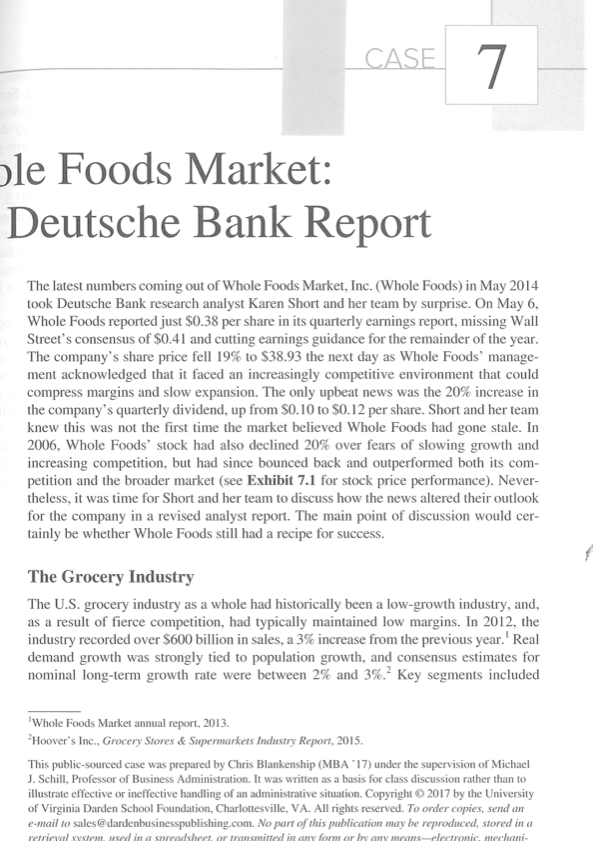
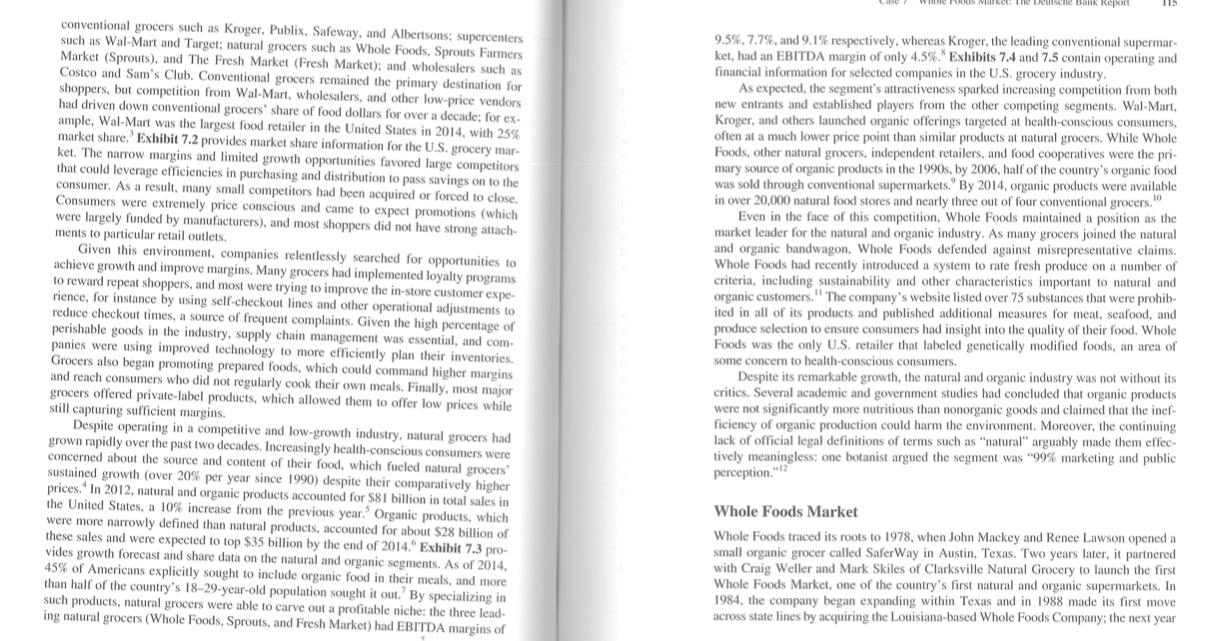
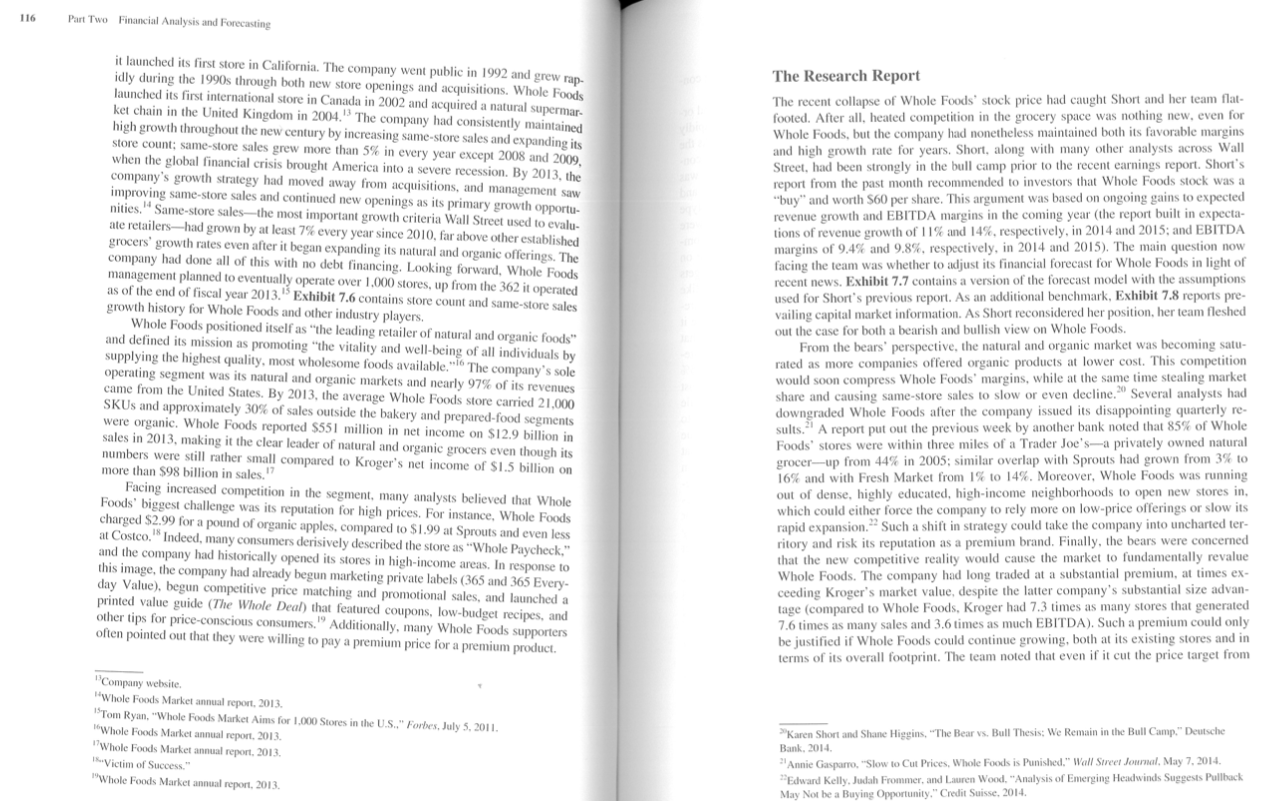
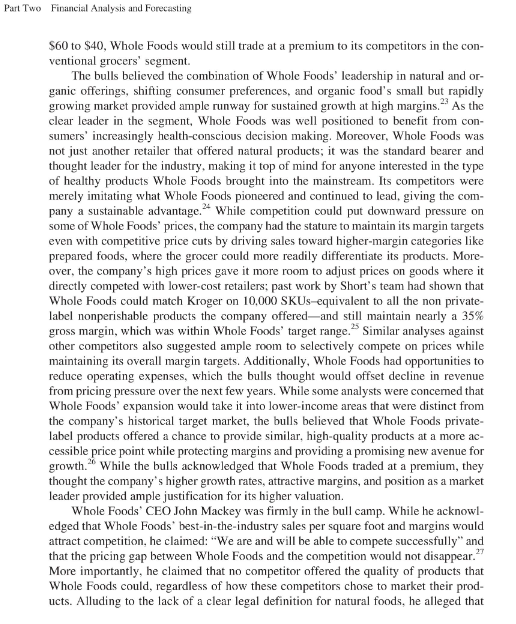
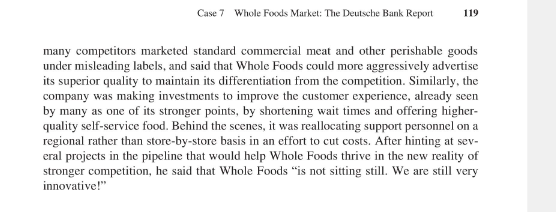
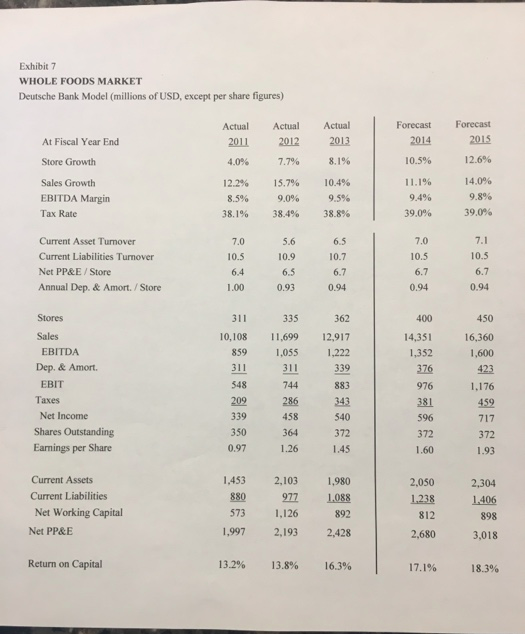
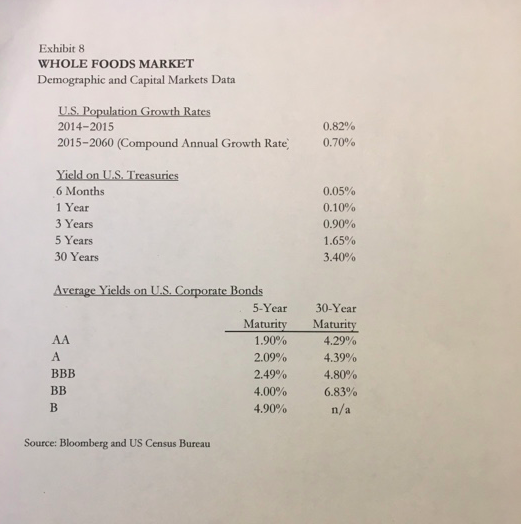
le Foods Market: Deutsche Bank Report The latest numbers coming out of Whole Foods Market, Inc. (Whole Foods) in May 2014 took Deutsche Bank research analyst Karen Short and her team by surprise. On May 6 , Whole Foods reported just $0.38 per share in its quarterly earnings report, missing Wall Street's consensus of $0.41 and cutting earnings guidance for the remainder of the year. The company's share price fell 19% to $38.93 the next day as Whole Foods' management acknowledged that it faced an increasingly competitive environment that could compress margins and slow expansion. The only upbeat news was the 20% increase in the company's quarterly dividend, up from $0.10 to $0.12 per share. Short and her team knew this was not the first time the market believed Whole Foods had gone stale. In 2006, Whole Foods' stock had also declined 20% over fears of slowing growth and increasing competition, but had since bounced back and outperformed both its competition and the broader market (see Exhibit 7.1 for stock price performance). Nevertheless, it was time for Short and her team to discuss how the news altered their outlook for the company in a revised analyst report. The main point of discussion would certainly be whether Whole Foods still had a recipe for success. The Grocery Industry The U.S. grocery industry as a whole had historically been a low-growth industry, and, as a result of fierce competition, had typically maintained low margins. In 2012, the industry recorded over $600 billion in sales, a 3% increase from the previous year.' Real demand growth was strongly tied to population growth, and consensus estimates for nominal long-term growth rate were between 2% and 3%.2 Key segments included 'Whole Foods Market annual report, 2013. 'Hoover's Inc., Grocery Stores \& Supenmarkets Industry Report, 2015. This public-sourced case was prepared by Chris Blankenship (MBA '17) under the supervision of Michael J. Schill, Professor of Business Administration. It was written as a basis for class discussion rather than to illustrate effective or ineffective handling of an administrative situation. Copyright 2017 by the University of Virginia Darden School Foundation, Charlottesville, VA. All rights reserved. To order copies, send an e-mail to sales@dardenbusinesspublishing.com. No part of this publication may be reproduced, stored in a $60 to $40, Whole Foods would still trade at a premium to its competitors in the conventional grocers' segment. The bulls believed the combination of Whole Foods' leadership in natural and organic offerings, shifting consumer preferences, and organic food's small but rapidly growing market provided ample runway for sustained growth at high margins. 23 As the clear leader in the segment, Whole Foods was well positioned to benefit from consumers' increasingly health-conscious decision making. Moreover, Whole Foods was not just another retailer that offered natural products; it was the standard bearer and thought leader for the industry, making it top of mind for anyone interested in the type of healthy products Whole Foods brought into the mainstream. Its competitors were merely imitating what Whole Foods pioneered and continued to lead, giving the company a sustainable advantage. 24 While competition could put downward pressure on some of Whole Foods' prices, the company had the stature to maintain its margin targets even with competitive price cuts by driving sales toward higher-margin categories like prepared foods, where the grocer could more readily differentiate its products. Moreover, the company's high prices gave it more room to adjust prices on goods where it directly competed with lower-cost retailers; past work by Short's team had shown that Whole Foods could match Kroger on 10,000 SKUs-equivalent to all the non privatelabel nonperishable products the company offered-and still maintain nearly a 35% gross margin, which was within Whole Foods' target range. 25 Similar analyses against other competitors also suggested ample room to selectively compete on prices while maintaining its overall margin targets. Additionally, Whole Foods had opportunities to reduce operating expenses, which the bulls thought would offset decline in revenue from pricing pressure over the next few years. While some analysts were concemed that Whole Foods' expansion would take it into lower-income areas that were distinct from the company's historical target market, the bulls believed that Whole Foods privatelabel products offered a chance to provide similar, high-quality products at a more accessible price point while protecting margins and providing a promising new avenue for growth. 26 While the bulls acknowledged that Whole Foods traded at a premium, they thought the company's higher growth rates, attractive margins, and position as a market leader provided ample justification for its higher valuation. Whole Foods' CEO John Mackey was firmly in the bull camp. While he acknowledged that Whole Foods' best-in-the-industry sales per square foot and margins would attract competition, he claimed: "We are and will be able to compete successfully" and that the pricing gap between Whole Foods and the competition would not disappear. 2T More importantly, he claimed that no competitor offered the quality of products that Whole Foods could, regardless of how these competitors chose to market their products. Alluding to the lack of a clear legal definition for natural foods, he alleged that many competitors marketed standard commercial meat and other perishable goods under misleading labels, and said that Whole Foods could more aggressively advertise its superior quality to maintain its differentiation from the competition. Similarly, the company was making investments to improve the customer experience, already seen by many as one of its stronger points, by shortening wait times and offering higherquality self-service food. Behind the scenes, it was reallocating support personnel on a regional rather than store-by-store basis in an effort to cut costs. After hinting at several projects in the pipeline that would help Whole Foods thrive in the new reality of stronger competition, he said that Whole Foods "is not sitting still. We are still very innovative!" Exhibit 7 WHOLE FOODS MARKET Deutsche Bank Model (millions of USD, except per share figures) Exhibit 8 WHOLE FOODS MARKET Demographic and Capital Markets Data Source: Bloomberg and US Census Bureau le Foods Market: Deutsche Bank Report The latest numbers coming out of Whole Foods Market, Inc. (Whole Foods) in May 2014 took Deutsche Bank research analyst Karen Short and her team by surprise. On May 6 , Whole Foods reported just $0.38 per share in its quarterly earnings report, missing Wall Street's consensus of $0.41 and cutting earnings guidance for the remainder of the year. The company's share price fell 19% to $38.93 the next day as Whole Foods' management acknowledged that it faced an increasingly competitive environment that could compress margins and slow expansion. The only upbeat news was the 20% increase in the company's quarterly dividend, up from $0.10 to $0.12 per share. Short and her team knew this was not the first time the market believed Whole Foods had gone stale. In 2006, Whole Foods' stock had also declined 20% over fears of slowing growth and increasing competition, but had since bounced back and outperformed both its competition and the broader market (see Exhibit 7.1 for stock price performance). Nevertheless, it was time for Short and her team to discuss how the news altered their outlook for the company in a revised analyst report. The main point of discussion would certainly be whether Whole Foods still had a recipe for success. The Grocery Industry The U.S. grocery industry as a whole had historically been a low-growth industry, and, as a result of fierce competition, had typically maintained low margins. In 2012, the industry recorded over $600 billion in sales, a 3% increase from the previous year.' Real demand growth was strongly tied to population growth, and consensus estimates for nominal long-term growth rate were between 2% and 3%.2 Key segments included 'Whole Foods Market annual report, 2013. 'Hoover's Inc., Grocery Stores \& Supenmarkets Industry Report, 2015. This public-sourced case was prepared by Chris Blankenship (MBA '17) under the supervision of Michael J. Schill, Professor of Business Administration. It was written as a basis for class discussion rather than to illustrate effective or ineffective handling of an administrative situation. Copyright 2017 by the University of Virginia Darden School Foundation, Charlottesville, VA. All rights reserved. To order copies, send an e-mail to sales@dardenbusinesspublishing.com. No part of this publication may be reproduced, stored in a $60 to $40, Whole Foods would still trade at a premium to its competitors in the conventional grocers' segment. The bulls believed the combination of Whole Foods' leadership in natural and organic offerings, shifting consumer preferences, and organic food's small but rapidly growing market provided ample runway for sustained growth at high margins. 23 As the clear leader in the segment, Whole Foods was well positioned to benefit from consumers' increasingly health-conscious decision making. Moreover, Whole Foods was not just another retailer that offered natural products; it was the standard bearer and thought leader for the industry, making it top of mind for anyone interested in the type of healthy products Whole Foods brought into the mainstream. Its competitors were merely imitating what Whole Foods pioneered and continued to lead, giving the company a sustainable advantage. 24 While competition could put downward pressure on some of Whole Foods' prices, the company had the stature to maintain its margin targets even with competitive price cuts by driving sales toward higher-margin categories like prepared foods, where the grocer could more readily differentiate its products. Moreover, the company's high prices gave it more room to adjust prices on goods where it directly competed with lower-cost retailers; past work by Short's team had shown that Whole Foods could match Kroger on 10,000 SKUs-equivalent to all the non privatelabel nonperishable products the company offered-and still maintain nearly a 35% gross margin, which was within Whole Foods' target range. 25 Similar analyses against other competitors also suggested ample room to selectively compete on prices while maintaining its overall margin targets. Additionally, Whole Foods had opportunities to reduce operating expenses, which the bulls thought would offset decline in revenue from pricing pressure over the next few years. While some analysts were concemed that Whole Foods' expansion would take it into lower-income areas that were distinct from the company's historical target market, the bulls believed that Whole Foods privatelabel products offered a chance to provide similar, high-quality products at a more accessible price point while protecting margins and providing a promising new avenue for growth. 26 While the bulls acknowledged that Whole Foods traded at a premium, they thought the company's higher growth rates, attractive margins, and position as a market leader provided ample justification for its higher valuation. Whole Foods' CEO John Mackey was firmly in the bull camp. While he acknowledged that Whole Foods' best-in-the-industry sales per square foot and margins would attract competition, he claimed: "We are and will be able to compete successfully" and that the pricing gap between Whole Foods and the competition would not disappear. 2T More importantly, he claimed that no competitor offered the quality of products that Whole Foods could, regardless of how these competitors chose to market their products. Alluding to the lack of a clear legal definition for natural foods, he alleged that many competitors marketed standard commercial meat and other perishable goods under misleading labels, and said that Whole Foods could more aggressively advertise its superior quality to maintain its differentiation from the competition. Similarly, the company was making investments to improve the customer experience, already seen by many as one of its stronger points, by shortening wait times and offering higherquality self-service food. Behind the scenes, it was reallocating support personnel on a regional rather than store-by-store basis in an effort to cut costs. After hinting at several projects in the pipeline that would help Whole Foods thrive in the new reality of stronger competition, he said that Whole Foods "is not sitting still. We are still very innovative!" Exhibit 7 WHOLE FOODS MARKET Deutsche Bank Model (millions of USD, except per share figures) Exhibit 8 WHOLE FOODS MARKET Demographic and Capital Markets Data Source: Bloomberg and US Census Bureau













